Dakgalbi is the most irresistible Korean chicken stir fry, perfect as a flavour-packed dinner or fun meal with friends! Loaded with succulent chicken in a spicy gochujang sauce, stir fried to perfection with chewy rice cakes and delicious veggies.
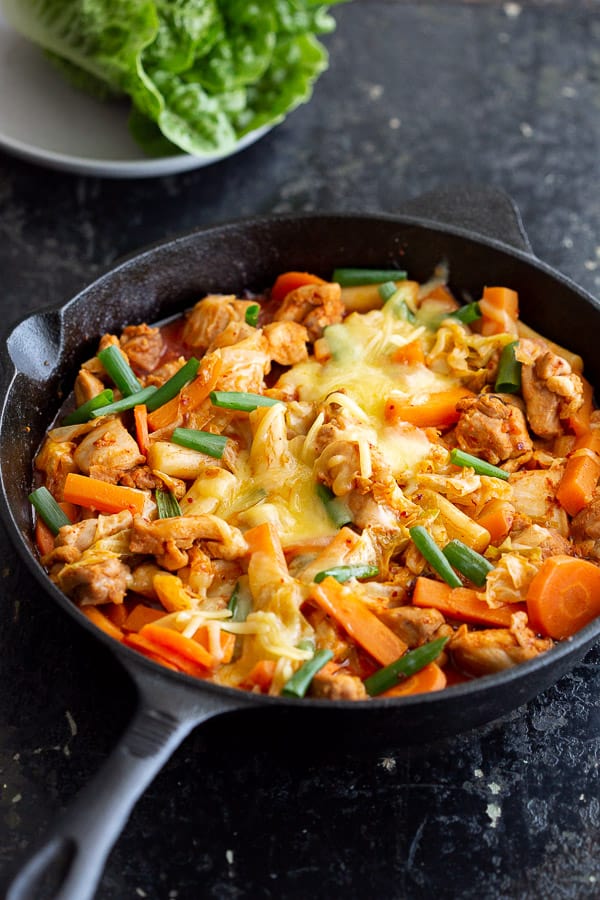
In This Post You’ll Learn
Why We Love This
This homemade dakgalbi recipe is the BEST combination of juicy chicken, chewy rice cakes and melty cheese, all stir fried to perfection in a deliciously spicy gochujang sauce.
We love that this amazing Korean spicy chicken stir fry is super adaptable to your tastes, and a great way to use up veggies from the fridge.
Why not make a big batch and freeze leftovers for later, or serve them up the next day as dakgalbi fried rice.
Related: Gochujang Pasta / Tteokkochi Skewers
What’s the difference between dakgalbi and dak bulgogi?
Both dak-galbi and dak-bulgogi are made with chicken (dak or 닭갈비 in Korean) and are quite similar in flavour. However, dak bulgogi is marinated and grilled chicken without vegetables and has a more intense burst of spice and flavour. It’s cooked Korean BBQ style on a grill over an open flame. Dak galbi includes veggies and garaetteok rice cakes, and is traditionally stir fried in a large cast iron skillet.
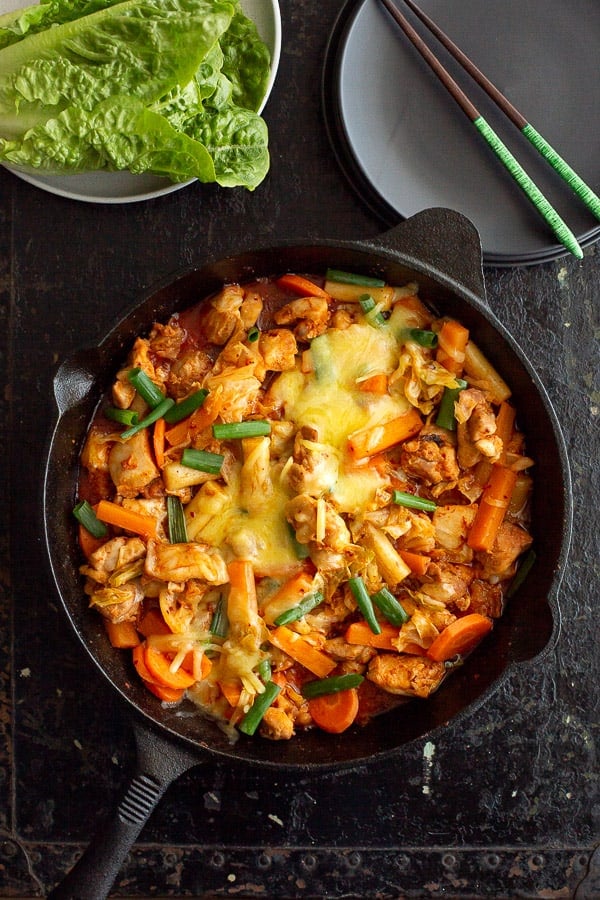
What is Dakgalbi?
Dakgalbi (닭갈비) is a type of anju (Korean food served alongside soju or beer). It’s said to have originated in the city of Chuncheon, Gangwon Province, in South Korea.
At Korean dakgalbi restaurants, it’s usually cooked on an extra large frying pan on large circular tables. It’s a great way for groups of friends to catch up while watching the ingredients cooking away in the pan!
This spicy Korean stir fry consists of bite size pieces of chicken marinated in a spicy gochujang based sauce, stir fried with garaetteok rice cakes, cabbage, carrot and sweet potato.
If you manage to make it through most of the huge serving, you can have freshly cooked rice or instant ramen stir fried through the leftovers to finish off the meal.
Today’s recipe is for cheese dakgalbi, a popular variation of this restaurant speciality. It’s finished off with an iconic (and delicious) cheese strip melted across the centre. The spicy flavour of the marinade pairs amazingly well with the yummy melted cheese!
It’s up to you if you want to cook it at the table with friends, or keep it simple and cook it on the stove.
What You’ll Need
For the marinade:
- Gochujang / Korean Hot Pepper Paste – One of the key flavours in Korean cuisine. While it is spicy, it has more of a well-rounded, sweet tomato flavour rather than just pure chilli heat. (Note: You can buy an extra hot version if you want!). It’s available at Asian grocery stores, well stocked supermarkets in the international aisle, or online. If you can’t source it, you can make a paste out of regular red chilli flakes mixed with sugar and a dash of soy. Use 1 tablespoon of chilli flakes for every tablespoon of gochujang required.
- Gochugaru / Korean Red Chilli Flakes – May also be labelled as Korean hot pepper powder. Most brands have clear packaging so you can see the product inside (which is important). Ideally you should buy the flakes, NOT the powdered version. Look for it at Asian supermarkets or online. Sub with half the listed amount of cayenne pepper or regular chilli powder.
- Cooking Wine – You can use Korean rice wine (cheongju), Japanese rice wine (sake) or Chinese style cooking wine (shao xing) depending on what you have on hand. Find them at Asian grocery stores or online. Sub with dry sherry, mirin or a splash of dry white wine if you have those on hand instead.
- Other Seasonings – You’ll also need garlic, ginger, soy sauce, sesame oil and sugar.
For the stir fry ingredients:
- Chicken – Use boneless chicken thighs for extra juicy and tender chicken pieces that really soak up the flavours in the marinade. You can also use chicken breast if you prefer. Sub with beef or pork strips, or diced firm tofu for a vegetarian version.
- Garaetteok (가래떡 / Korean Rice Cakes) – These are the chewy cylindrical rice cakes you’ll find in other Korean dishes like tteokbokki. We usually buy them frozen from our local Asian supermarket.
- Cabbage – Wombok or napa cabbage is preferred, otherwise just use any variety you have on hand.
- Other Veggies – Carrot and sweet potato diced into chips around 5cm / 2 in long, and finely sliced spring onion / green onion. You can use regular potato instead of sweet potato, but allow extra cooking time if you do. Feel free to use up other veggies out of the fridge if you need!
- Cheese – Shredded mozzarella cheese is perfect for melting, otherwise cheddar or pizza cheese are also great options.
- Perilla Leaves (Optional) – The flavour of fresh perilla leaves is like a combination of mint and anise. Pop a handful of shredded perilla on top while cooking, or serve the whole leaves separately to use as wraps.
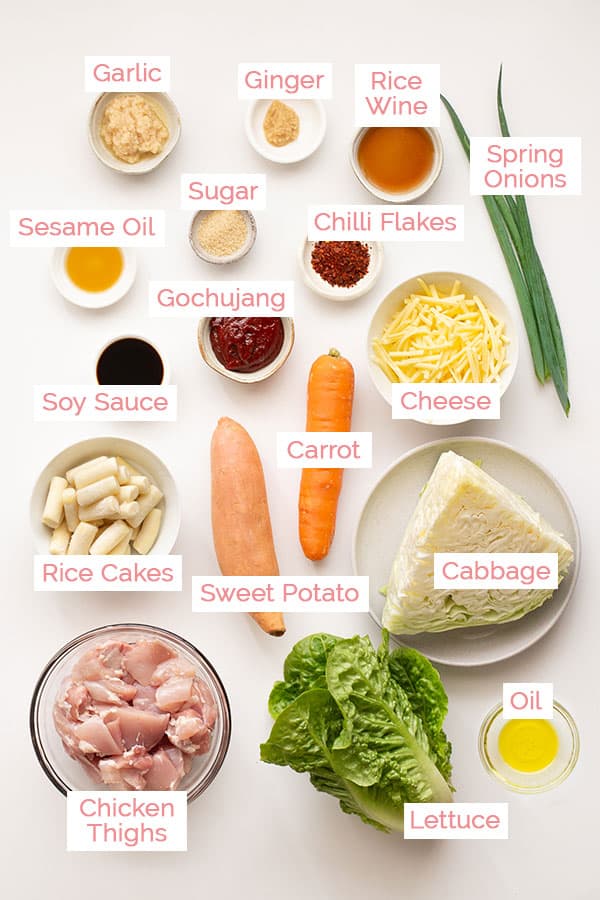
How to make Dakgalbi
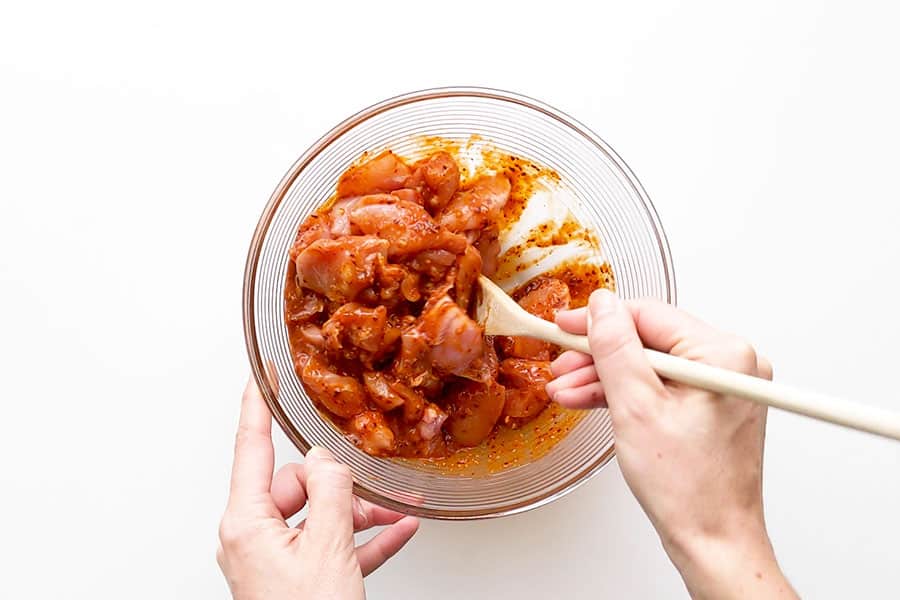
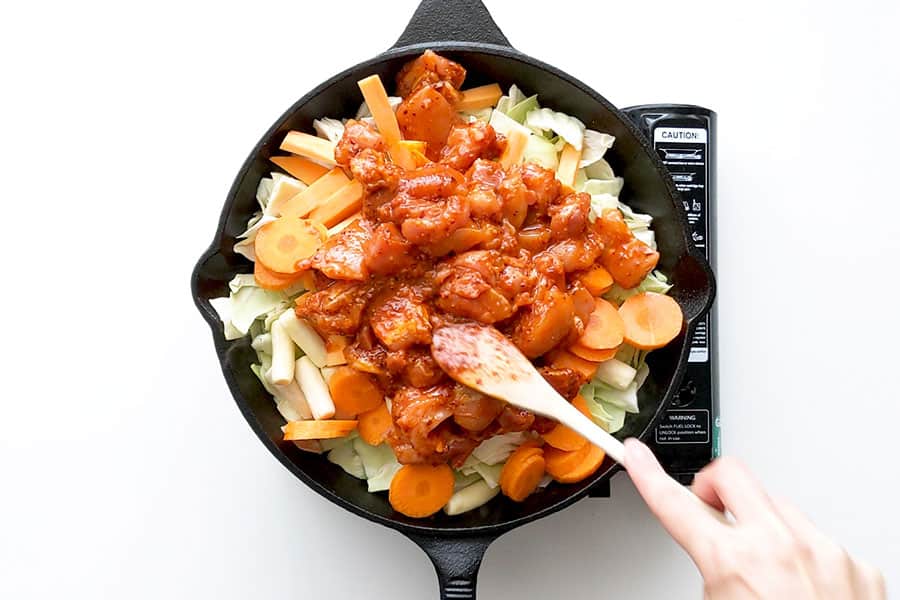
First, gather your ingredients: See recipe card below for measurements.
- Mix together the gochujang, garlic, soy sauce, rice wine, sesame oil, gochugaru, sugar and ginger in a medium sized mixing bowl. Add the diced chicken and stir well to make sure every piece is well coated in the marinade. Cover and pop in the fridge to marinate for at least 30 mins (or overnight for more flavour!)
- Heat the vegetable oil in a large flat-bottomed frying pan or cast iron pan over a medium high heat. Layer in the cabbage, carrot, sweet potato and rice cakes. Top with marinated chicken, allow to cook for a minute or two, then reduce the heat and stir fry until cooked through. Tip: You can cover with a lid to steam the ingredients and help the sweet potato and chicken cook through faster.
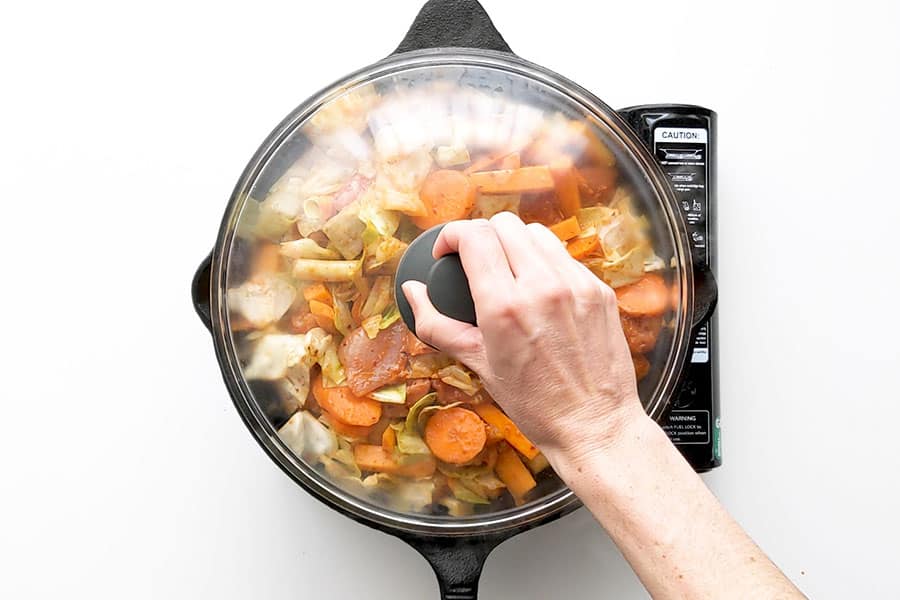
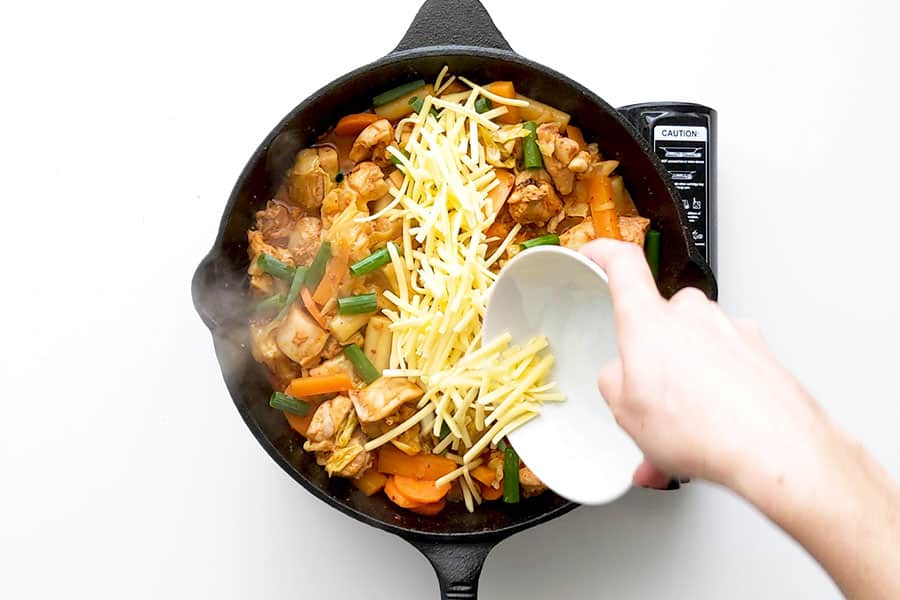
- Keep an eye on the ingredients and stir regularly to make sure they don’t stick to the bottom or sides of the pan. After about 10 minutes, take off the lid to allow the sauce to thicken.
- Once the chicken is cooked through, garnish with spring onion and sprinkle grated cheese down the centre. Once melted, the dak galbi is ready to eat!
Optional: Serve with rice and/or lettuce leaves to wrap.
Wandercook’s Tips
- Cast Iron – For best results, cook in a wide, flat bottomed pan. It’s traditionally cooked in a dakgalbi pan, but we used a 15 inch cast iron pan which works a treat! Cast iron works well to keep the dish cooking, and keep everything hot once the heat is turned off. Make sure to run the oil around the pan (bottom and side) before cooking to stop the ingredients from sticking.
- Cook Together – If you have a portable induction cooker and an induction suitable frying pan, or an electric frying pan, you can cook this dish right on the table with friends and family. (If you only have a portable gas stove, we recommend cooking outside for proper ventilation). It’s so entertaining and a great way to enjoy delicious food and fun conversation together. But you can also just as easily cook it on the stove and portion out into individual bowls.
- Serve as Wraps – Wrap small scoops of dakgalbi in lettuce or fresh perilla leaves. Serve with fresh or pickled garlic, pickled onions and ssamjang dipping sauce!
- Storage – Leftovers will last 2-3 days in the fridge in an airtight container, or can be frozen for 2-3 months.
FAQs
Marinating the chicken overnight will bring much more flavour to the finished dish. But it’s not essential – if you’re in a rush or just want dinner on the table quickly, you can get away with 15-30 mins marinating time.
At restaurants, the dish is usually served with fresh perilla or lettuce leaves, garlic and ssamjang sauce to wrap up the dakgalbi.
At home, we love having small bowls of rice and pickled daikon to munch on through the meal. For extra veggies, serve with a quick bean sprout salad or seasoned spinach. For more mouthwatering Korean side dishes check out our banchan recipe guide.
Variations
- Make it Spicier – Use more chilli flakes and/or add kimchi for an extra spicy hit!
- Make it Milder – Use less chilli flakes and gochujang. Replace with ½ tsp of chicken stock powder to give it a little extra flavour without the heat. Or use our soy sauce based bulgogi sauce instead.
- Even More Flavour – Add 1 tsp Korean curry powder into the marinade.
- Dakgalbi Fried Rice – Near the end of the meal, add a cup of cooked rice, kimchi, seaweed and an egg. Stir fry until the egg is cooked through and the rice has soaked up all the leftover flavour in the pan.
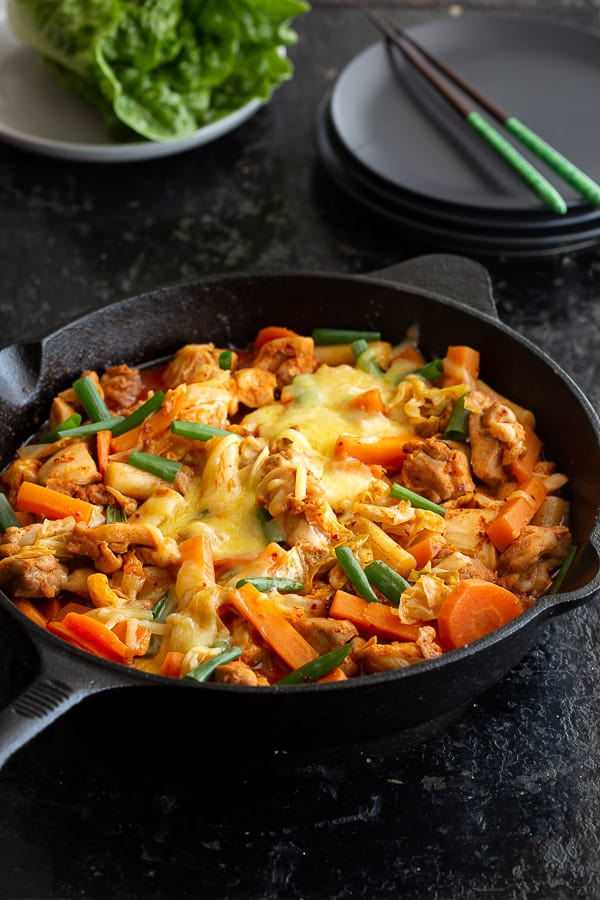
Try these amazing recipes next:
- Gamja Jorim – Epic spicy Korean potatoes, so full of flavour!
- Dubu Jorim – Deliciously spicy tofu bites braised to perfection.
- Rabokki – The best combination of instant ramen and rice cakes in a fiery sauce.
- Korean Army Stew – A super quick and easy Korean hot pot.
- Chicken Bibimbap – Easy homemade Korean rice bowls with spicy chicken.
★ Did you make this recipe? Please leave a comment and a star rating below!
Equipment
- Large flat-bottomed fry pan, cast iron fry pan, or portable electric cooker
Ingredients
Stir Fry Ingredients:
- 600 g chicken thighs diced (around 4 thighs)
- 1/4 cabbage 2-3 cups once diced
- 1 carrot sliced
- 1 sweet potato cut into chips around 5cm long (or 2 regular potatoes)
- 1-2 cups Korean rice cakes (tteok) (tteok)
- 3-4 spring onion / green onion green section only, cut into 3cm lengths
- vegetable oil for cooking
Marinade:
- 2 tbsp Korean hot pepper paste / gochujang
- 2 tbsp garlic
- 2 tbsp soy sauce
- 2 tbsp cooking rice wine / cooking sake or mirin
- 1 tbsp Korean hot pepper flakes / gochugaru
- 1 tbsp sugar
- 1 tsp sesame oil
- 1 tsp ginger
To Top:
- 1 cup cheese grated, tasty or pizza cheese
To Wrap (Optional):
- lettuce leaves small, leave as whole leaves
- perilla leaves / shiso leaves sliced for garnish, or leave as whole leaves
- freshly cooked rice
Instructions
For the Marinade:
- Mix together the gochujang, garlic, soy sauce, rice wine, sesame oil, gochugaru, sugar and ginger in a medium sized mixing bowl.2 tbsp Korean hot pepper paste / gochujang, 2 tbsp garlic, 2 tbsp soy sauce, 2 tbsp cooking rice wine / cooking sake, 1 tbsp Korean hot pepper flakes / gochugaru, 1 tbsp sugar, 1 tsp sesame oil, 1 tsp ginger
- Add the diced chicken and stir to make sure every piece is well coated in the marinade. Cover and pop in the fridge to marinate for at least 30 mins (or overnight for more flavour!)600 g chicken thighs
For the Dakgalbi:
- Heat the vegetable oil in a large flat-bottomed frying pan or cast iron pan over a medium high heat.vegetable oil
- Layer in the cabbage, carrot, sweet potato and rice cakes. Top with marinated chicken, allow to cook for a minute or two, then reduce the heat and stir fry until cooked through. Tip: You can cover with a lid to steam the ingredients and help the sweet potato and chicken cook through faster.1/4 cabbage, 1 carrot, 1 sweet potato, 1-2 cups Korean rice cakes (tteok)
- Keep an eye on the ingredients and stir regularly to make sure they don’t stick to the bottom or sides of the pan. After about 10 minutes, take off the lid to allow the sauce to thicken.
- Once the chicken is cooked through, garnish with spring onion and sprinkle grated cheese down the centre. Once melted, the dak galbi is ready to eat!3-4 spring onion / green onion, 1 cup cheese
- Optional: Serve with fluffy white rice and lettuce leaves or perilla leaves to wrap.lettuce leaves, perilla leaves / shiso leaves, freshly cooked rice
Video
Recipe Notes
- Cast Iron – For best results, cook this Korean chicken stir fry in a flat bottomed pan. It’s traditionally cooked in a dakgalbi pan, but we used a 15 inch cast iron pan which works a treat! Cast iron works well to keep the dish cooking, and keep everything hot once the heat is turned off. Make sure to run the oil around the pan (bottom and side) before cooking to stop the ingredients from sticking.
- Cook Together – If you have a portable induction cooker and an induction suitable frying pan, or an electric frying pan, this dish is fun and easy to cook right on the table with friends and family. It’s so entertaining and a great way to enjoy delicious food and fun conversation together. But you can also just as easily cook it on the stove and portion out into individual bowls.
- Serve as Wraps – Wrap small scoops of dakgalbi in lettuce or fresh perilla leaves. Serve with fresh or pickled garlic, pickled onions and ssamjang dipping sauce!
- Storage – Leftovers will last 2-3 days in the fridge in an airtight container, or can be frozen for 2-3 months.
- Make it Spicier – Use more chilli flakes and/or add store-bought or homemade kimchi for an extra spicy hit!
- Make it Milder – Use less chilli flakes and gochujang. Replace with ½ tsp of chicken stock powder to give it a little extra flavour. Or use our soy sauce based Korean bulgogi sauce instead.
- Even More Flavour – Add 1 tsp Korean curry powder into the marinade.
- Dakgalbi Fried Rice – Near the end of the meal, add a cup of cooked rice, kimchi, seaweed and an egg. Stir fry until the egg is cooked through and the rice has soaked up all the leftover flavour in the pan.
Nutrition
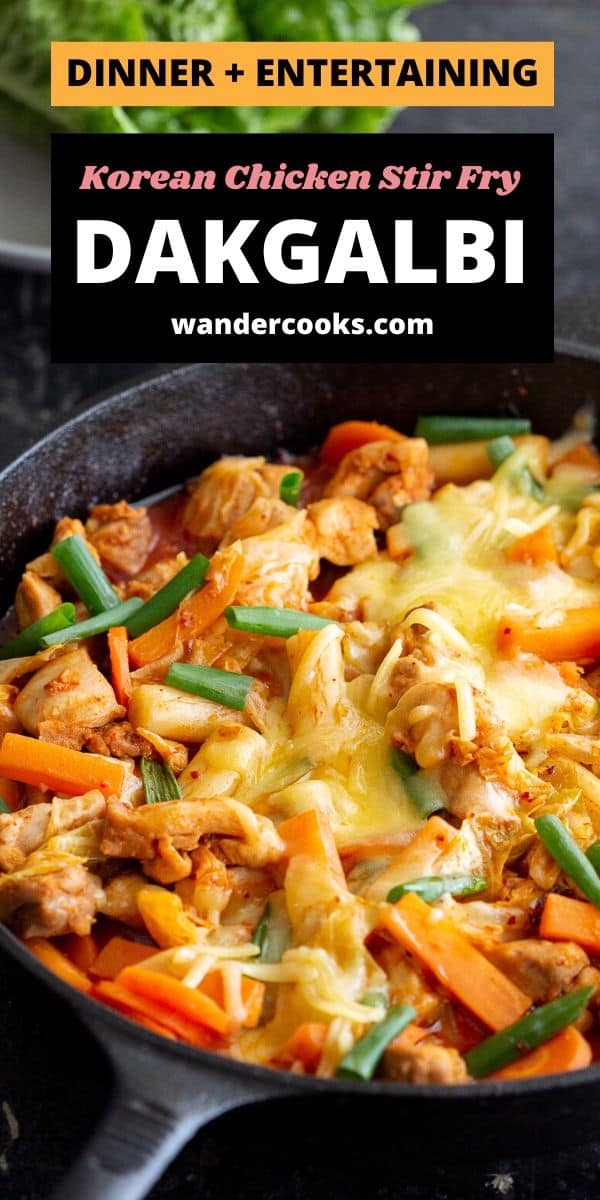

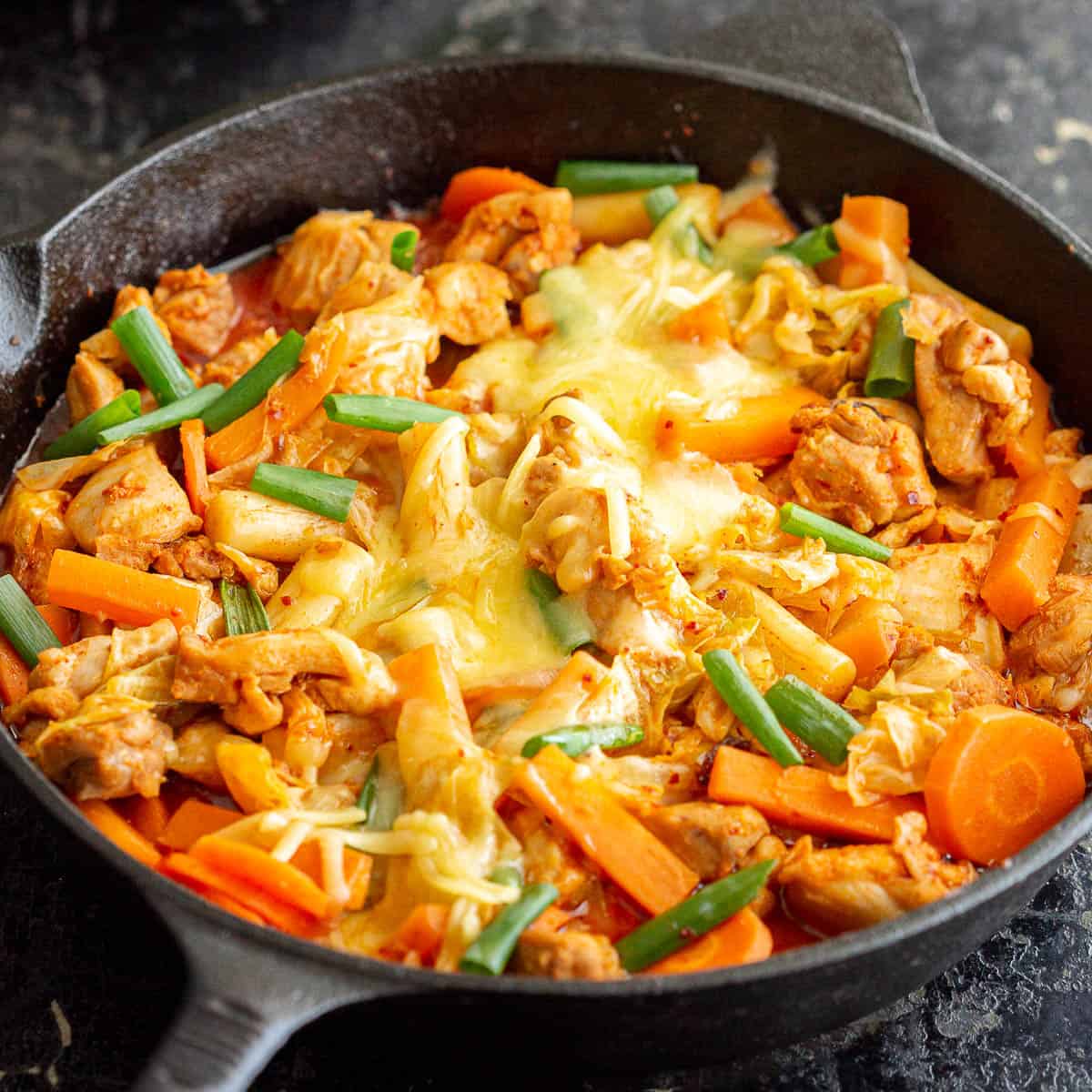



4 Comments
Jane Minervini
12/09/2021 at 8:20 pmI love Korean food and I enjoy cooking it at home. I made this recipe tonight and it was delicious. The cheese on top was unusual but it made the dish. I served it with some homemade kimchi which complimented the dish perfectly. Yum, yummity yum!
Wandercooks
13/09/2021 at 4:08 pmAmazing Jane! So happy to hear. I know what you mean about the cheese, when we first had it we were the same, now we’d never have it without it haha!
Deb Grayson
06/07/2020 at 7:58 pmCan’t wait to try this. I have everything but rice cakes. Is there a substitute? Thanks!
Wandercooks
07/07/2020 at 4:46 pmHey Deb, all good! You could add an extra potato in it’s place, or if you want something with a similar texture you could pop in some gnocchi (totally not Korean, but it will do in a pinch!). Otherwise, omit entirely and just serve it with rice. 🙂